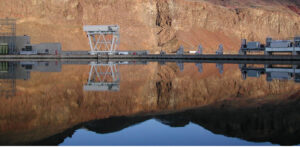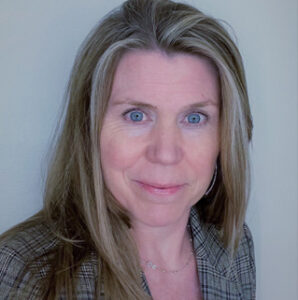The Chelan County Public Utility District (Chelan PUD) provides electric power, water and wastewater services, and broadband to 50,000–60,000 central Washington customers. The current 40‑year license on Chelan PUD’s nearly century-old Rock Island Dam expires in 2028, and the district is already working to consult its stakeholders in preparation for the relicensing process. In this interview, Chelan PUD’s hydro licensing manager, Janel Ulrich, tells Hydro Leader about how the district is thinking ahead about stakeholders, stewardship, and salmon and planning a future that works for everyone.
Hydro Leader: Please tell us about your background and how you came to be in your current position.
Janel Ulrich: I am the hydro licensing manager at Chelan PUD. I have worked for the district for 16 years. I am a chemical and environmental engineer, so I’m possibly an unlikely suspect for someone in my role. Before coming to the district, I worked in research and development, environmental cleanup, and a variety of other jobs. I joined Chelan PUD to assist with water quality for the Lake Chelan and Rocky Reach relicensing projects and to serve as a program manager for license implementation. After that, I worked on analytics, project management, risk management, portfolio management, and asset management before taking the hydro licensing manager position.
Hydro Leader: Please tell us about Chelan PUD.
Janel Ulrich: Chelan PUD is headquartered in Wenatchee in central Washington State. Washington State has a law that allows the voters of counties to set up public utility districts to provide utility services. Chelan PUD was created in 1936 to serve our rural community, and today we have about 50,000–60,000 customers in Chelan County.
We are a large hydropower producer, generating enough power for about 800,000 homes. We use transmission and distribution lines to get that power to our customers and to market. We also have small water and wastewater systems and a fiber-optic network that allows most people in the county to get high-speed internet.
We own three hydroelectric plants: Rocky Reach, Rock Island, and Lake Chelan, all of which have Federal Energy Regulatory Commission (FERC) licenses. Rock Island Dam sits on the main stem of the Columbia River. It has a nameplate capacity of about 630 megawatts. About 20 miles upstream is the Rocky Reach Dam. The Lake Chelan Dam sits at the end of Lake Chelan near the city of Chelan. There is a long penstock that runs down to a small 60‑megawatt project.
We value stewardship. We operate and maintain a proactive fisheries program with a number of hatcheries, and we have a system of recreational parks that are open to the public. We have a five-member board that is elected by the citizens of Chelan County.
Hydro Leader: Please tell us about the history of Rock Island Dam and its licensing.
Janel Ulrich: Rock Island Dam was built in the early 1930s. It was the first powerhouse on the Columbia River, and its original license was obtained under the Federal Power Commission. We got our second license, a 40‑year license, in 1989. It will expire at the end of 2028. We are in the process of acquiring our third license for this project.

Hydro Leader: Will the new license also have a term of 40 years?
Janel Ulrich: FERC is allowed to provide a license of 30–50 years; the default is 40 years. We hope we may be able to obtain a 50‑year license. We are now working on modernizing the powerhouses and spillway, and we’ve done a significant amount of work for fish passage.
Hydro Leader: Your current license’s expiration in 2028 is still a number of years away. Is this a typical time frame for relicensing?
Janel Ulrich: The timeline is usually based on the size and complexity of the project and the basin in which the project is located. We worked on the relicensing of Lake Chelan and Rocky Reach Dams for 8–10 years. The requirement is that 5–5½ years prior to the expiration of your license, you submit a preapplication document and a notice of intent to FERC, thus starting the formal relicensing process. However, an applicant may get together with its various stakeholders and begin the process earlier. That is what we have elected to do so that we can ensure that there is plenty of time for dialogue with stakeholders—to listen to them, identify issues, and come up with creative solutions together. Also, by starting earlier, we hope to reduce the amount of time spent toward the end of relicensing. We want a license that protects environmental and cultural resources and provides value for our customer-owners and the community at large.
Hydro Leader: Who are the stakeholders you are working with?
Janel Ulrich: The stakeholders in a relicensing process include federal and state agencies, tribes, local governments, nongovernmental organizations, and community members. Anyone in the general public can be part of the process.
Hydro Leader: Would you give us an example of how working with your stakeholders led to a creative solution to a problem?
Janel Ulrich: I think my favorite example of what we mean by creative solutions came out of our Lake Chelan project. The water flows from Lake Chelan through a tunnel, or penstock, to the powerhouse. There’s a bypass reach where the water flowed before the project was built and the dam stopped that water flow part of the year. Stakeholders wanted water restored to that bypass reach because there was the potential to create great salmon and steelhead habitat at the very bottom of the river. We had a few choices: We could have released a significant amount of water, which would have brought the lake level down and had big effects on recreational use and on a variety of different users in Lake Chelan, or we could do what we did, which is to bring together biologists and engineers to build a small pumping station by the powerhouse and create a manmade fish-friendly habitat. Now, after we generate power, we pump the water right back to the top of the fourth reach and put it through this habitat. It is a wildly successful project: We have far more fish habitat than anyone ever envisioned, we preserve the lake levels necessary for recreational needs, and we’re still able to generate power. By bringing people together to pursue common goals, we were able to come up with a creative solution that met a variety of different needs.
Hydro Leader: What are the resources you are trying to protect at Rock Island?
Janel Ulrich: We are trying to protect all the fish, wildlife, habitat, recreation, and cultural resources affected by project operations. Three Endangered Species Act (ESA) species are known to exist in the project boundary: spring Chinook salmon, bull trout, and steelhead. Bull trout are managed under a management plan consistent with a biological opinion from the U.S. Fish and Wildlife Service. In addition, Rock Island has a habitat conservation plan in place for salmon and steelhead. It covers two ESA-listed species and two species that are not listed but have the same life cycles. The habitat conservation plan has been in place since 2004 to make sure that we have good passage survival. We have spectacular passage survival at Rock Island Dam. We adjust our spill, we adjust our gates, and we work with the tribes and agencies that are parties to that 50‑year agreement. We have hatcheries and a tributary fund for projects that produce additional habitat for salmon and steelhead. We have amazing partners who actively work with us on habitat conservation plan implementation.
Hydro Leader: What are the next steps in the relicensing process?
Janel Ulrich: We recently held a stakeholder workshop to identify issues pertaining to the relicensing agreement. Starting in January, we’re going to have an engagement workshop and then start technical working groups. The working groups will look at the issues, identify any gaps, and make sure that there’s causation, meaning that they will ensure that any issues we consider relate to project operations. We will ascertain what aspects should be evaluated and get moving on studies as warranted. All that information will be included in the preliminary application document in 2023 as we move into the formal process.
Hydro Leader: A 50‑year license would end in 2079. Presumably, many things may change over that term, including the population, water use patterns, and the climate. How do those factors influence the requirements for a license?
Janel Ulrich: That’s a great question, because those can be complicated things to evaluate. There are different scenarios people can choose to model. For example, we will do a forecast study based on projected population growth to assess whether our recreational facilities are sufficient for the future. In evaluating natural resources, adaptive management can give scientists the ability to do things differently as conditions change. Beyond that, we have to ensure that our projects are sustainable and reliable. We are putting a significant amount of money and effort into modernizing both of our powerhouses and our spillway so that they will be safe, high-producing projects decades into the future.
Hydro Leader: What lessons learned from previous licensing projects will you be bringing to this one?
Janel Ulrich: The biggest takeaway is how important it is to value the expertise and the stewardship roles of our stakeholders. Bringing folks together to work in coordination with our internal talent always produces the best solution. We need to be clear about what the goals are for the resources we want to protect, what specific impacts we need to mitigate for and enhance, and then work side by side with our partners to figure out what the right solutions are.
Hydro Leader: Is there anything you would like to add?
Janel Ulrich: This reservoir sits right in the middle of two good-sized communities, Wenatchee and East Wenatchee, and there are also several small towns along the reservoir. A lot of people, including our employees, live, play, and work here. This is our backyard. Most of us know exactly what the level of the river is, what birds fly overhead, and what’s happening in the softball fields. We’ve got a little more skin in the game, because this is home.
Hydro Leader: What is your vision for the future of Chelan PUD?
Janel Ulrich: The vision of the district is to stay true to our values, which are safety, stewardship, operational excellence, and trustworthiness. We take those very seriously. Our motto is to try to provide the best for the most for the longest. We continue to look at the long term, which includes relicensing. We’re publicly owned and are here for the long haul. This is where we live, this is where we work, and this is the power our families rely on.
Janel Ulrich is the hydro licensing manager at the Chelan County Public Utility District. She can be contacted at janel.ulrich@chelanpud.org.


